Why You Have a Pimple-Like Rash
Medically reviewed by Susan Bard, MD
Hives, rosacea, or several other skin conditions can cause pimple-like rashes on the face or body. The rash may be red or otherwise discolored, itchy, or inflamed.
This article will cover the common causes of pimple-like rashes, how to treat them, and when to see a healthcare provider.
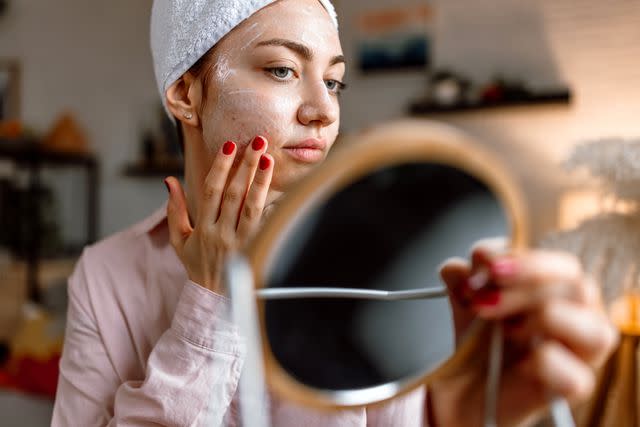
J_art / Getty Images
Describing Your Pimple-Like Rash
Skin rashes can present in a multitude of ways. The characteristics of the rash and accompanying symptoms can vary. The primary factor that distinguishes one rash from another is its underlying cause. The cause will create the symptoms and characteristics of the rash.
The following characteristics of a rash should be evaluated:
Color
Size
Edges
Swelling
Texture
Allergic Reactions That Cause Pimple-Like Rash
Hives is a skin condition that can cause pimple-like rashes on the skin. Below is a description of hives, its symptoms, and treatment.
Hives
Hives are itchy rashes that form suddenly on the skin. They can occur anywhere on the skin and can be caused by an allergic reaction, stress, or temperature changes. Hives can occur at any age and are a common childhood skin condition. The symptoms of hives include:
Raised skin patches that may be red or purple depending on skin tone
Itchy
Varying sizes
Blanch when touched
Hives' appearance can be mistaken for acne or pimple rashes. Hives treatment focuses on removing the cause and soothing the itch and redness with antihistamines and topical creams. More serious cases will need to be seen by a healthcare provider.
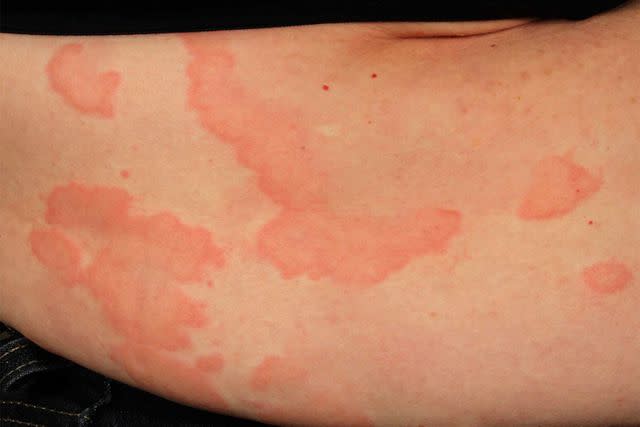
Reproduced with permission from ©DermNet and ©Raimo Suhonen dermnetnz.org 2023.
Skin Conditions With Pimple-Like Rash as a Symptom
Numerous skin conditions present with pimple-like rashes. Below is a list of those rashes, their symptoms, and treatments.
Folliculitis
Folliculitis is a skin condition in which the hair follicle becomes blocked or damaged. It can happen after shaving or when the skin rubs against clothes. The blocked or damaged follicle often gets infected and forms a pimple-like bump. Other symptoms include:
Small pimples or pustules
Redness
Itching
Folliculitis can occur anywhere in which there are hair follicles but is more commonly seen on the neck, armpits, and groin. It can typically be treated at home with warm compresses but may need antibiotics if more severe.
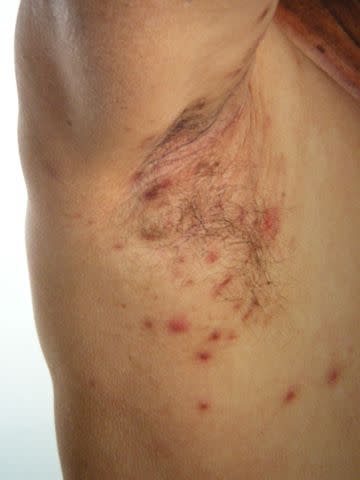
Reproduced with permission from ©DermNet dermnetnz.org 2023
Milia
Milia are tiny, white skin cysts caused by a buildup of keratin. Individually they are called milium. These skin bumps tend to be seen on the face, around the eyes, and cheeks .In the area of the cysts, the skin will be slightly firm. There should be no itching or redness in the surrounding skin. Milia are harmless and typically do not need to be treated. To have milia removed and prevent scarring, see a healthcare provider for treatments.
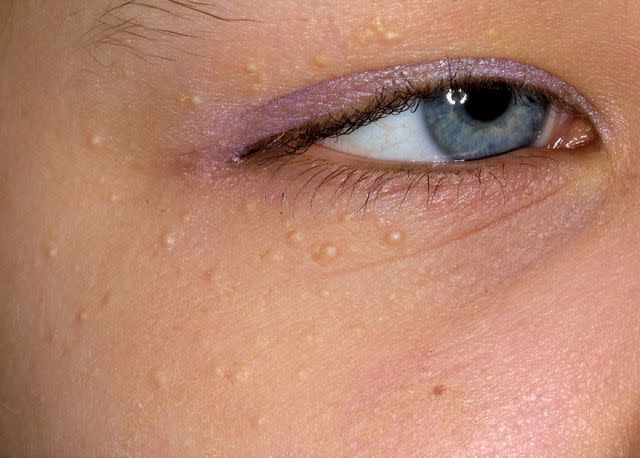
Reproduced with permission from ©DermNet and ©Raimo Suhonen dermnetnz.org 2023.
Rosacea
Rosacea is an inflammatory skin condition that causes redness on the face, typically on the cheeks and nose. It may appear brownish or violet in darker skin types. The symptoms can come and go with certain factors like stress and sunlight causing it to appear. The symptoms of rosacea include:
Face redness or purple tone
Pimple-like bumps
Skin thickening
Rosacea tends to appear in middle-aged adults and is more severe in men. There is no cure for rosacea but a healthcare provider can prescribe treatments which may include topical creams, lasers, and surgery.
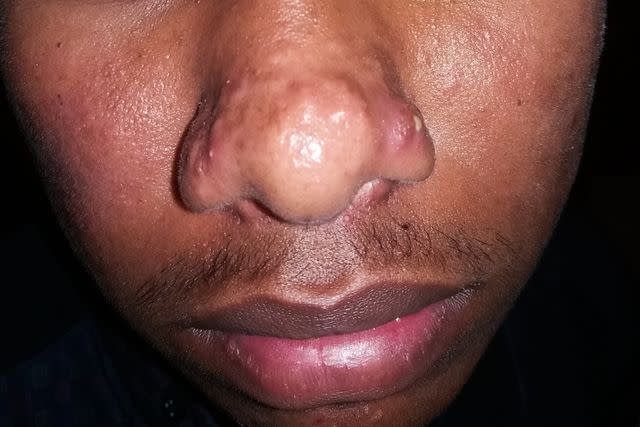
Reproduced with permission from ©DermNet New Zealand and ©Dr. Mashihul Hossain www.dermnetnz.org 2023.
Keratosis Pilaris
Keratosis pilaris is a skin condition that presents as tiny bumps that look like goosebumps. These bumps are made up of dead skin cells and look like small pimples. They tend to be seen on the arms and legs but can also appear on the face. Keratosis pilaris symptoms include:
Rough, dry skin
Tiny bumps
Skin colored or white
Itching
The treatment of keratosis pilaris focuses on exfoliating and moisturizing the skin. Moisturizing creams that are used to treat keratosis pilaris often contain lactic acid or urea. Improvement can take from four to six weeks, and it's important to stick to the treatment plan for best results.
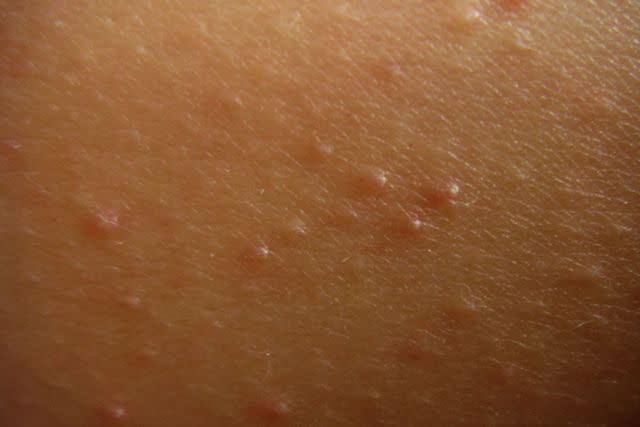
Reproduced with permission from ©DermNet New Zealand dermnetnz.org 2023.
Perioral Dermatitis
Perioral dermatitis is a rash that occurs around the mouth. It is red and is often confused with acne. It can be caused by an allergy to a product that is being used on or around the mouth. It also can be caused by using hydrocortisone for too long. The symptoms may include:
Raised rash
Itching or burning
Scaly skin
Small, pimple-like bumps
The first step to treat perioral dermatitis is to use a gentle, fragrance-free face wash. A healthcare provider might prescribe an antibiotic which should be taken as prescribed.
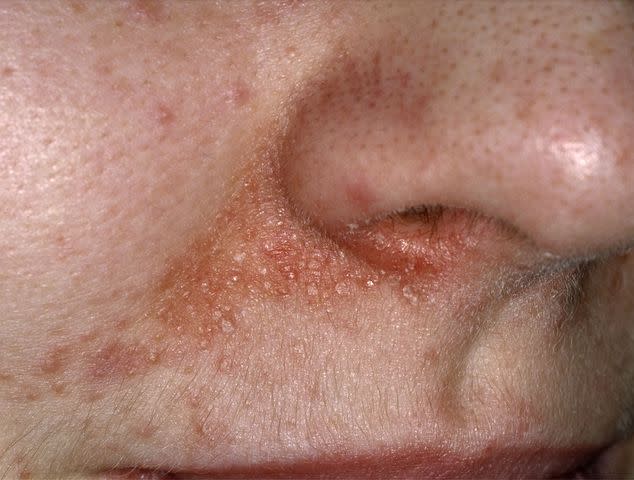
Reproduced with permission from ©DermNet and ©Raimo Suhonen dermnetnz.org 2023.
Autoimmune Causes of Pimple-Like Rash
Hidradenitis suppurativa is another condition that causes a pimple-like rash. Below is a description of hidradenitis suppurativa, its symptoms, and treatments.
Hidradenitis Suppurativa
Hidradenitis suppurativa is an autoimmune condition that causes boil-like bumps under the skin. These bumps become painful and can break open. The bumps tend to be found in the underarms and groin but can also develop in other locations where skin touches skin. The condition typically starts during or after puberty and is more common in females.
A healthcare provider is needed to treat hidradenitis suppurativa. They may prescribe treatments like antibiotics, topical creams or ointments to decrease pore blockages, or oral medications.
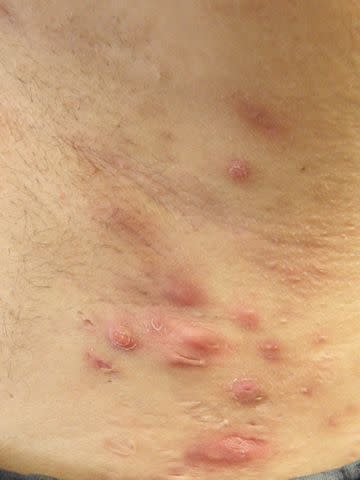
Reproduced with permission from ©DermNet dermnetnz.org 2023.
Infectious Causes of Pimple-Like Rash
Infections can cause pimple-like rashes. Below is a description of the infections, their symptoms, and treatments.
Staph
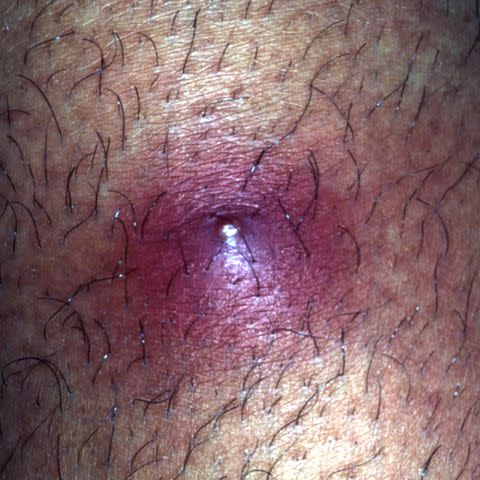
Reproduced with permission from ©DermNet dermnetnz.org 2023.
Staphylococcus (staph) is a type of bacteria that causes many types of infections. It is commonly found on the skin and when there is a sore or opening in the skin, it can enter and cause an infection. The symptoms of a skin staph infection are:
Bumps that look like pimples or boils
Redness or (purple coloration on darker skin tones)
Swelling
Pain
Skin crusting
Staph skin infections are treated with antibiotics. It can be a topical cream or an oral antibiotic, depending on the type and severity of the infection.
Molluscum
Molluscum is a skin condition caused by the poxvirus. It produces small bumps that are either white or the color of the surrounding skin. The bumps do not hurt or itch. They can be found anywhere on the body and are commonly found on the trunk, arms, and legs. Molluscum spreads easily from direct person-to-person contact in such public places as swimming pools and daycare centers.
Since molluscum does not cause many symptoms, some people may choose to allow the rash to heal on its own. This can take six months to four years. For those who choose to treat their molluscum, a healthcare provider can use a laser or cryotherapy (destroying abnormalities with freezing temperatures) to remove the bumps.
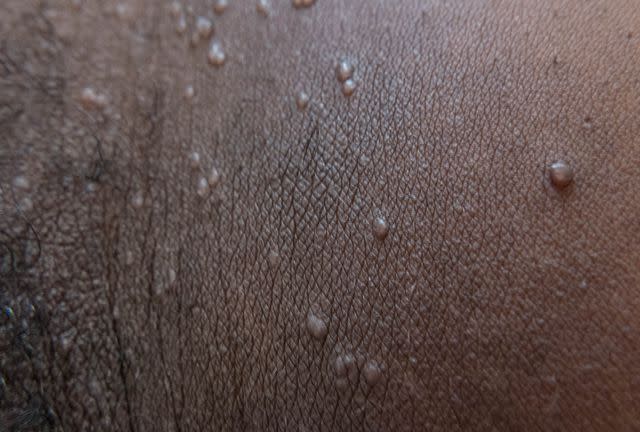
Reproduced with permission from ©DermNet dermnetnz.org 2023.
Chicken Pox
Chicken pox (varicella-zoster virus) is a very contagious infection that causes intensely itchy blister-like bumps on the skin. The bumps tend to start on the chest, face, and back then spread to the rest of the body. The symptoms of chicken pox include:
Fever
Headache
Tiredness
Fluid-filled blisters
Intense itching
The chicken pox vaccine, the varicella vaccine, has decreased the incidence of the condition, although, people who have had the vaccine can have breakthrough infections. Treatment is aimed at reducing the symptoms. This includes using calamine lotion, colloidal oatmeal, or a cool bath with baking soda.
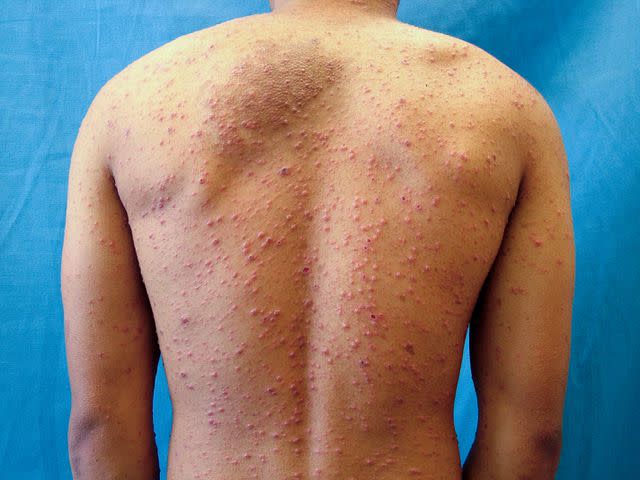
Reproduced with permission from ©DermNet and ©Te Whatu Ora Waikato dermnetnz.org 2023
How to Heal Rashes Resembling Acne
The first step to healing a rash that resembles acne is to determine the type of rash and its underlying cause.
Each type of rash will have a different treatment method and may include any of the following:
Cryotherapy
Topical ointments
Moisturizer
When to Ask a Healthcare Provider
Rashes can be difficult to diagnose at home. Anytime a new rash appears, contact a healthcare provider. They will be able to evaluate the rash, determine its cause, and develop a treatment plan specific to your needs. Other circumstances that warrant a call to a healthcare provider are:
Summary
Pimple-like rashes can form on the face or body. They may be accompanied by redness, swelling, and itching. There are numerous causes of these rashes like hives, rosacea, and folliculitis. A healthcare provider should be seen to determine the cause and recommend a treatment plan.
Read the original article on Verywell Health.

